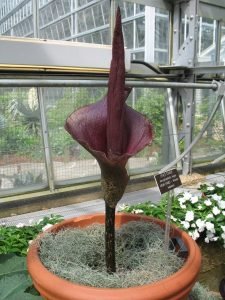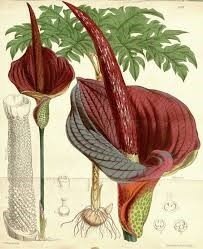Amorphophallus konjac is a large, perennial plant commonly diseases present in different regions of Asia. It grows as a central rod like structure that is single, elongated plants which is called a corm and also contain a large leaf which surrounds the corm or central rod.
 The size of that leaf is about 4 feet around, which is commonly called the konnyaku potato. The tuber plant is normally grow in Asian countries the most famous are China, Japan and Thailand, Indonesia and very rare found in some regions of Pakistan. The food made from the corm of these plants is widely used in the noodles pastas, mecronies and other food products. The scientific name of this plant is “Glucomannan” because it’s the major constituent present in it, and also called by its common names in different regions of different countries which include konjac mannan, snake plant and konnyaku, devil’s tongue, elephant foot yam and konjac.
The size of that leaf is about 4 feet around, which is commonly called the konnyaku potato. The tuber plant is normally grow in Asian countries the most famous are China, Japan and Thailand, Indonesia and very rare found in some regions of Pakistan. The food made from the corm of these plants is widely used in the noodles pastas, mecronies and other food products. The scientific name of this plant is “Glucomannan” because it’s the major constituent present in it, and also called by its common names in different regions of different countries which include konjac mannan, snake plant and konnyaku, devil’s tongue, elephant foot yam and konjac.
Amorphophallus Konjac Plant

When Amorphophallus konjac mixed with water it forms a gelatinous mass, which is not digested by the body after ingesting. Then this gelatinous mass of Amorphophallus konjac moves through our digestive system and stimulated the peristalsis of the stomach and the intestines that enhance the digestion of food and also maintain the walls of stomach. The glucomannan is very effective in weight loss and control cholesterol level in the body. It actually acts like a sponge in the stomach and give you a fully bulky effect. Also it takes more time to pass through the large intestine and small intestine and cannot be digest, in this way it decreases the feel of hunger and thus reduces the caloric demand in body resulting in the weight loss without affecting the daily life. The gelatinous mass of glucomannan also seizes substances along the gastric tract as it moves through the digestive system. This property of Amorphophallus konjac is often used as a natural laxative. The reported daily amount for weight loss is 2g in two times with 1g each time along with 2 glass of water before eating. However, for rapid results the amount should me3g/day with 1g each time. The higher the quantity will block your stomach and you feel loss of energy and carries bad effect on your routine working.

Konjac glucomannan (KGM) obtained from Amorphophallus konjac tubers which is its basic components. It is a polysaccharides having a high molecular weight containing primarily of mannose and glucose sugars units that have soluble dietary fibers. It contains Β,1-4 D-mannose, and D-glucose that makes natural polysaccharide Konjac Glucomannan. The ratio of glucose and mannose is 1:1.6 and are branched at the 3rd carbon of mannose. The degree of branching between D-mannose and D-glucose is about 8% and acetyl group substitute is 5-10%. It is an amorphous polymer with molecular weight 500-2000 KDa. The viscosity of KGM is very high (0.5g/100g) which is higher among the other major polysaccharides. The viscosity of Konjac Glucomannan (1.0g/100g) is about 30,000cps.
The extraction of konjac glucomannan is done by washing, then slicing into small pieces, shade drying and grinding into powder; then by wind shifting technique the konjac flour (KF) is separated out. KF contains cellulose and insoluble starches, different types of proteins and lipids and some impurities. Due to which the floor has high turbidity but the refined powder has Glucomannan in the range of 50-70 g/100g depending on the source. Whereas purified powder has konjac glucomannan content more than 90g/100g.
In last decade, a number of methods are developed for the extraction of KF and purification of KGM from KF.
- Dry method/ Mechanical processing
- Wet method/ Chemical processing
In dry method, dried konjac chips are grind and make konjac flour called Crude Konjac Flour (CKF). Then by wind shifting method the CKF is converted into KF. In this method the low purity Konjac flour produced is used for food purposes.
In wet method, several techniques are applicable, for example enzyme treatment, dialysis, alcohol washings, treatment at different temperatures or a combination of different methods.
Mostly, Lead acetate is used in the wet processing method along with salt (e.g. aluminum sulphate), starch hydrolyzing enzymes and ethanol to extract KGM from CKF. This processed product cannot be used as edible due to lead acetate, thus its applications are limited only in the non-food industries. While enzymatic purification involves degradation of starch by hydrolyzing enzymes.
KGM is also an attractive candidate for the preparation of composite materials, biodegradable film and controlled release matrix in medicine, cosmetics and fine chemical fields. They can be widely used in food industry as functional ingredients due to their thickening, stabilizing, texture-modification and film-forming properties
It is also used for the treatment of different kind of diseases. In different parts of China this konjac is used for the treatment of coughs, asthma, hernias, breast pain, burns and different kinds of skin diseases disorders. According to the latest research articles it is showed that the use of konjac glucomannan supplementation can significantly reduce the plasma cholesterol, improve the bowel movement, enhance the carbohydrate metabolism and also encourage the healthy clone of the body.
Glucomannan can overcome the risk for cardiovascular disease and controls the cholesterol levels. It is also beneficial in digestion and lowers the stress response. Glucomannan is also approved by its effectiveness in immune functions and creating the balance in Harmons.
Recently number of scientific studies has been proved glucomannan helps to the diabetic patients due to delaying the digestion process that helps the stomach to absorb more sugar from the food Scientists are working on different modifications to be made on Glucomannan and make it a favorable material to use in the textile industry. One of the major works in textile industry is to use as a sizing material in replace of conventional materials like PVA and starch owing to its gelling behavior and increased hydrophilicity. As textile is a widely flourishing industry in whole world, this type of innovation will be a milestone in this field.
Also scientists are working on the formation of system for controlled release of drug diseases by capsules formation. A small chemical modification has made it possible to increase the solubility and hydrophilicity.
This article is collectively authored by Afzal Ahmad & Muhammad Waheed Iqbal Ecological Dyeing and Finishing Laboratory & State Key Laboratory of Food Science and Technology Jiangnan University, 1800 Lihu Avenue, Wuxi, Jiangsu 214122, China.